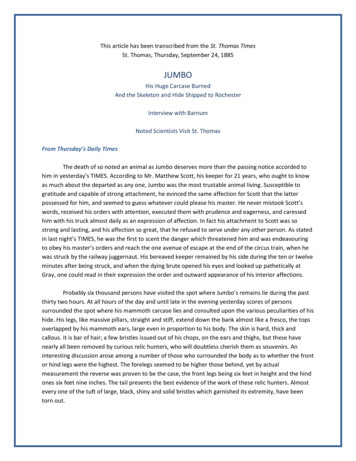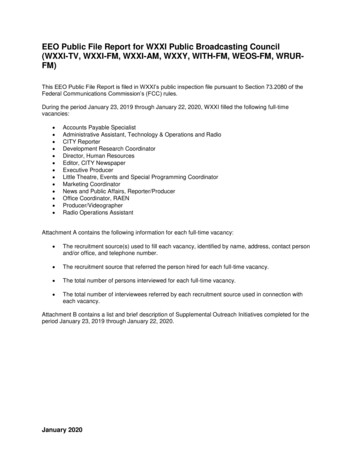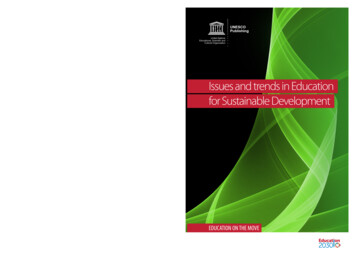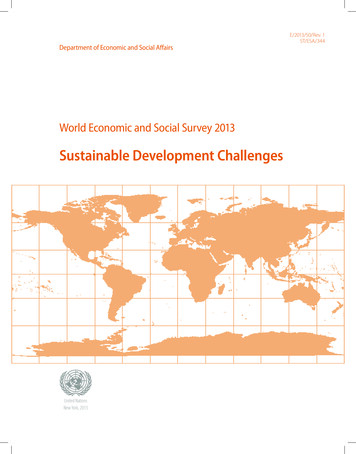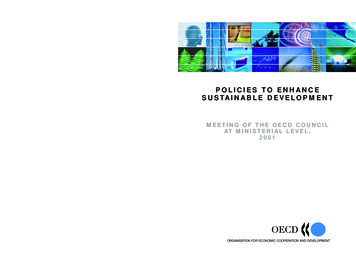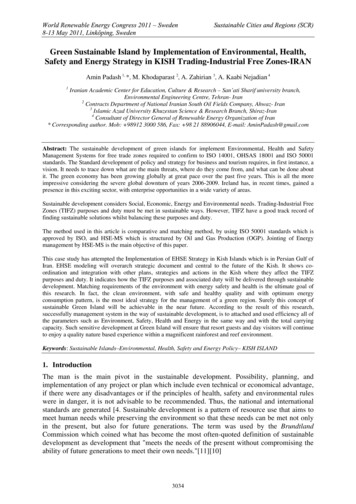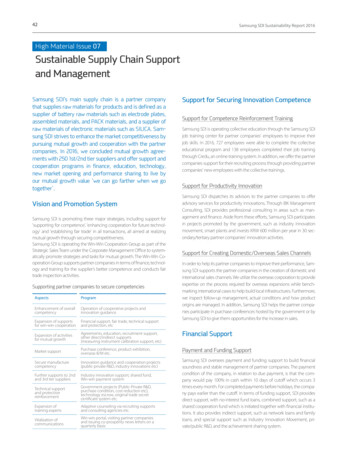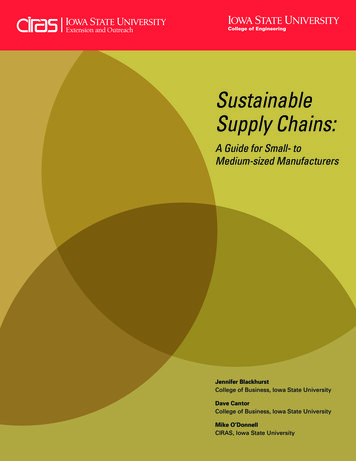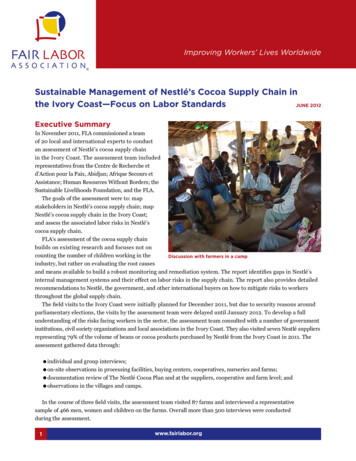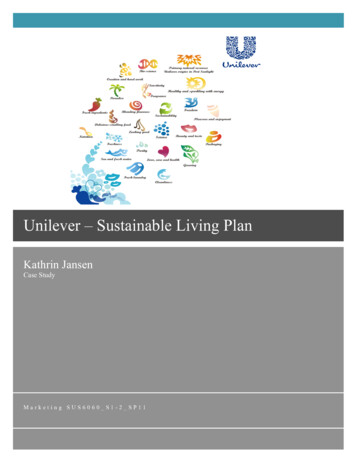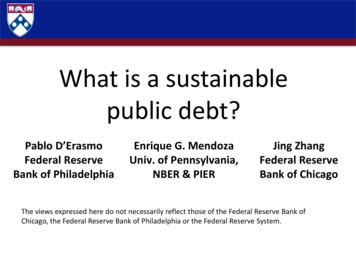
Transcription
What is a sustainablepublic debt?Pablo D’ErasmoFederal ReserveBank of PhiladelphiaEnrique G. MendozaUniv. of Pennsylvania,NBER & PIERJing ZhangFederal ReserveBank of ChicagoThe views expressed here do not necessarily reflect those of the Federal Reserve Bank ofChicago, the Federal Reserve Bank of Philadelphia or the Federal Reserve System.
Public debt sustainability Literal definition: a sustainable debt is that whichcan be maintained at a certain rate or level In macro literature:1. Under commitment: debt consistent with solvency(IGBC) and/or a stationary equilibrium2. Without commitment: debt supported in equilibria withdefault risk Critical question in fiscal policy analysis– 2008-11, debt ratios rose by 31 (20) ppts. in U.S. (Europe)– Global market of local-currency gov. bonds was 1/2 ofworld’s GDP in 2011 ( 30 trillion, 6 times investmentgrade external sov. debt)
Layout of the lecture1. Critical review of “classic” approach2. Empirical approach: Bohn’s Fiscal ReactionFunction3. Structural approach: Two-country DGE withfiscal sector that matches actual tax baseelasticities4. Domestic default approach: Model of optimaldefault driven by distributional incentives5. New applications to U.S. and cross-countrydata, and analysis of their implications
Generic government budget constraints Period GBC with Arrow gov. securities:– In GDP ratios and under perfect foresight: NPG condition arbitrage yields IGBC:
Classic approach Proposed by Buiter (1985), Blanchard (1990), andwidely used in policy institutions (IMF, 2015) At steady-state & under perfect foresight, GBCyields “Blanchard ratio” (debt-stabilizing pb): First flaw: Disconnected from initial debt and IGBC– FRFs with different coefficients satisfy IGBC for sameinitial debt but converge to different steady states, andcan even go to infinity!
Classic approach (contn’d) Second flaw: Ignores uncertainty & asset markets Mendoza & Oviedo (06, 09): under incompletemarkets, adding shocks smoothing (or tolerablemin. outlays) yields “Natural Public Debt Limit:”– Blanchard ratio uses l.r. means (always violates NPDL)– NPDL tighter for economies with more volatilerevenues or less able to adjust outlays– Debt follows random walk with boundaries:
Argentina: Simulated debt dynamics(starting from 30% debt, calibrated revenue process, gmin 12.4, NPDL 55.7)
Empirical Approach: Bohn’s Contributions1. IGBC tests discounting at risk free rate are misspecified:2. IGBC holds if debt or outlays interest are integrated of anyfinite order (no particular integration order needed)3. Linear FRFwithis sufficientfor IGBC (debt is stationary if, or diverges to infinity ifbbut is still sustainable! )4. Empirical tests based on historical U.S. data 1791-2003support linear FRF and some nonlinear variations
New FRF Estimates U.S. estimates (1791-2014) and cross-countrypanels (1951-2013) again pass sufficiency test– EMs have stronger response, less access to debt Structural break post-2008 (lower response,large residuals, large primary deficits) U.S. deficits larger than in previous “debt crises,”much larger than out-of-sample pre-08 forecast FRFs with lower response coefficient satisfy IGBCat same initial debt, but with larger deficits &higher long-run debt
Public Debt Crises in U.S. History(net federal debt-GDP ratio, 1791-2014)
U.S. Primary Deficits after Debt Crises
New FRF Estimates: U.S. 1792-2014
U.S. Primary Balance Post-2008 Forecast(2009-2020 forecast from 1791-2008 FRF regression)Out-of-sample forecast uses actual values for the independent variablesfor 2009-2014 and 2016 President’s Budget for 2015-2020
Debt Projections: Alternative FRFs
Structural Approach FRFs with different parameters satisfy IGBC for sameinitial debt, but macro dynamics and welfare differand FRFs can’t compare them Use calibrated variant of workhorse two-countryNeoclassical model to compare fiscal adjustmentpolicies in response to initial debt shocks Match observed elasticities of tax bases to taxchanges by introducing endogenous utilization andlimited depreciation tax allowance
Model highlights Deterministic setup with exogenous long-run growthdriven by labor-augmenting technological change Fiscal sector includes taxes on capital, labor andconsumption, gov. purchases, transfers and debt Utilization choice & limited tax allowance for depreciation Trade in goods and bonds (residence-based taxation) Capital immobile across countries, but trade in bondsarbitrages post-tax returns & induces capital reallocation Unilateral tax changes have cross-country externalities(relative prices, wealth distribution, tax revenues)
Households Maximizesubject to:given
Firms Production technology: Firms maximize profits Optimality conditions equate marginalproducts with pre-tax factor prices
Fiscal sector Gov. purchases and transfers are exogenousand kept constant at initial steady-state levels GBC: IGBC:
Tax distortions and externalities Asset markets arbitrage (ignoring capital adj.costs): Labor market: Capacity utilization :
Calibration: Fiscal Heterogeneity
Parameters from Data & Literature
Parameters from Steady-State Conditions
Quantitative exercises Unilateral changes in capital or labor taxes “Passive” country adjusts to tax externalities in order tomaintain revenue neutrality (changes labor tax) Construct dynamic Laffer curves (DLCs): change in PDVof primary balance (i.e. in sustainable debt) Compare against what is needed to make actualincreases in debt sustainable (match “new” IGBC) Examine macro dynamics and welfare effects Perturbation method with shooting routine (accounts forsteady-state dependency on initial conditions)
Main findings Capital taxes:1. Large externalities (strategic incentives)2. US: debt not sustainable (DLC max below required level)3. EU15: inefficient side of DLC (tax cut makes debt sustainablevia external effects--closed-economy DLC also peaks belowrequired level)4. Without utilization and limited allowance short-run taxelasticity has wrong sign and DLC is linearly increasing Labor taxes:1. Negligible externalities2. US lower initial taxes yield DLCs that sustain high debt3. EU15: DLCs (closed or open) peak below required level
Capital Tax Dynamic Laffer Curves
Effects of Setting US Capital Tax at Max.
Capital Tax Base Elasticities: Models v. Data
U.S. Capital Tax DLCs: Alternative Models
Labor Tax Dynamic Laffer Curves
Domestic Default Approach Previous two approaches cast doubt on chancesof restoring fiscal solvency via conventional tools European crisis historical evidence (Reinhart &Rogoff (11), Hall & Sargent (14)) raise possibilityof domestic defaults– A “forgotten history” (R&R) until recently (D’Erasmo& Mendoza (2013,14), Dovis et al. (2014), ) Remove commitment: Distributional incentiveslead to default unless costs are sufficiently highor gov. favors bond holders– Solvency is not enough to make debt sustainable!
Optimal Domestic Default(D’Erasmo & Mendoza, JEEA 2016) Two-period model with two types of risk-averse agents(L, H), with fraction 𝛾 of L-types (𝑏0𝐿 𝑏0𝐻 ) Gov. collects lump-sum taxes 𝜏, faces stochastic g,issues bonds 𝐵 (g and default are non-insurableaggregate risks) Default is costly as a fraction 𝜙 𝑔 of income thatvaries with realization of g (a’la Arellano (2008)) Gov. attains 2nd-best deviation from equal mg. utilitiesby redistributing via debt & default
Private AgentsPreferences:Date-0 budget constraints and initial wealth for i L,H:Date-1 budget constraints under repayment for i L,H:Date-1 budget constraints under default for i L,H:
Agents’ Optimization ProblemPayoff function for i L,H :with initial bond holdings given by initial wealth distribution andbond market clearing:
GovernmentBudget constraintsDefault optimization problem in 2nd period (utilitarian SWF):Debt issuance optimization problem in 1st period:
Default Decision in 2nd Period Assume bond demand choices given by: Socially optimal allocations (under repayment):– Zero consumption dispersion is first best If default is costless, it is always optimal (attains 1stbest) and debt cannot be sustained.– Cost makes default suboptimal (for some bonddemand choices dispersion is smaller with repayment)– Cost can be endogenized (liquidity, self-insurance) orreplaced with gov. bias favoring bond holders
Equilibria with & without default costs
Equilibria with Government Bias
Debt Issuance Decision in 1st Period Selling debt reduces dispersion at t 0, butincreases it at t 1 under repayment: Gov. internalizes how the gain of issuing debt ishampered by default risk, which lowers bondprices (debt Laffer curve).
Debt Issuance Optimality Condition Without default, some dispersion is optimal (debthelps relax L-types borrowing constraint) With default risk, more dispersion at t 0 is tradedoff for possibly zero at t 1 in default states
Calibration to European Data
Equilibrium Manifold as Share of Non-debt-holders Rises(calibration to European data)
Equilibria with Government Bias
Non-bond-holders may prefer bias!(if ownership is sufficiently concentrated)
Conclusions Three approaches to examine sustainable debt paint ableak picture of fiscal prospects:1. FRF structural break post-2008, deficits much largerthan predicted, and larger than in previous crises2. Capital tax DLCs peak well below required increase tooffset higher debt (except if EU exploits externalities)3. Default costs or gov. bias make debt exposed todefault risk due to distributional incentives sustainable4. Economies with concentrated debt ownership electbiased governments that sustain high debt at lowspreads and default probs.
can be maintained at a certain rate or level In macro literature: 1. Under commitment: debt consistent with solvency (IGBC) and/or a stationary equilibrium 2. Without commitment: debt supported in equilibria with default risk Critical question in fiscal policy analysis –20
